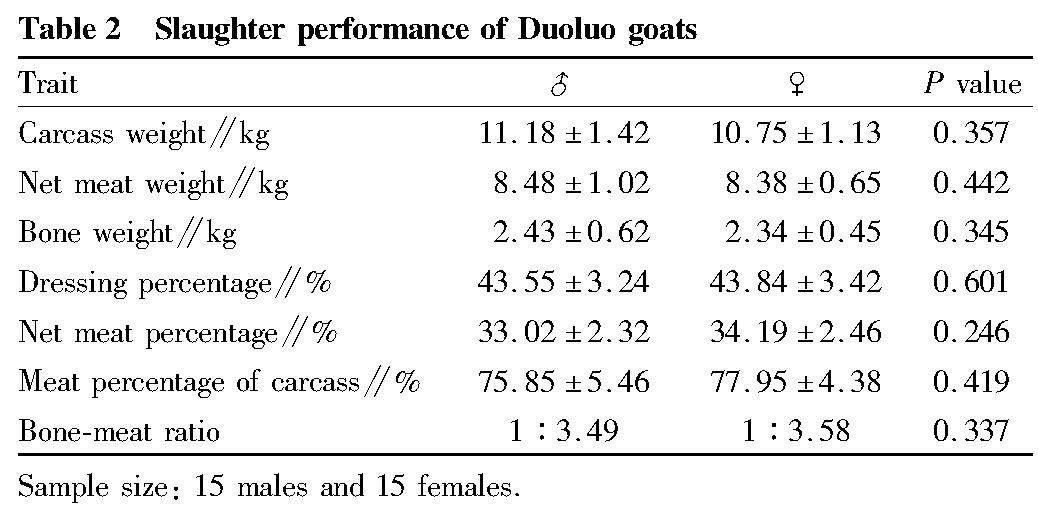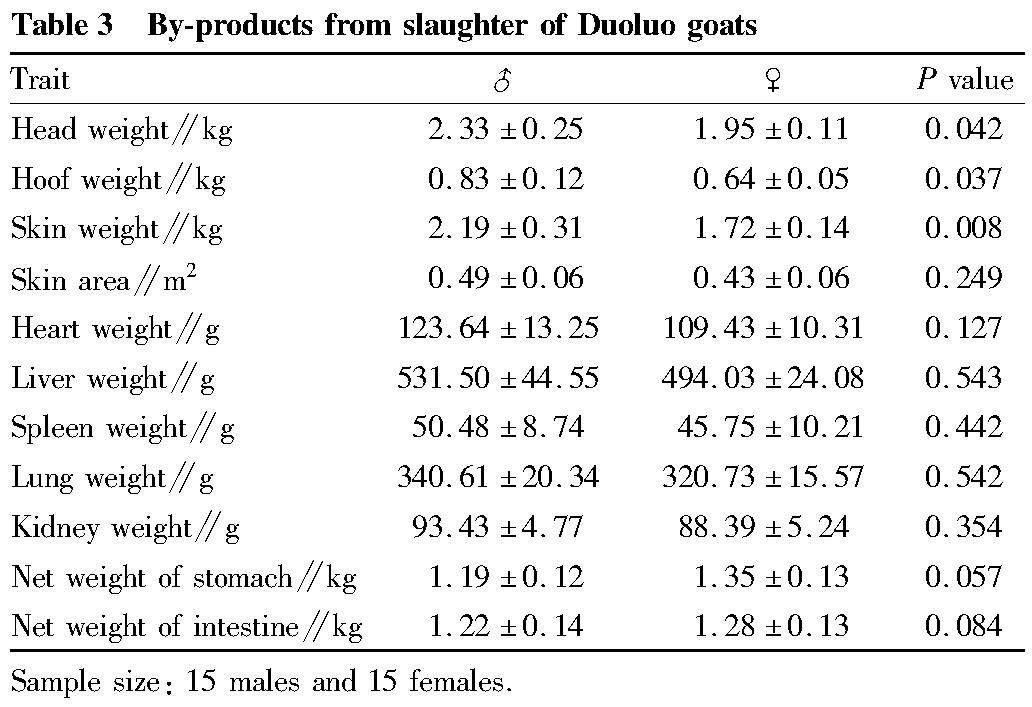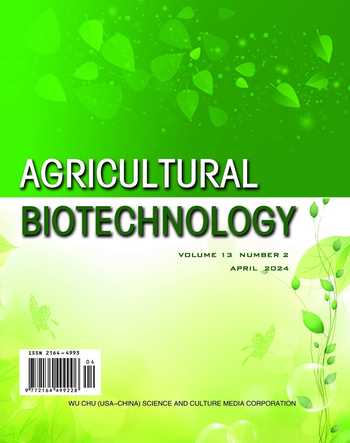Slaughter Performance, Muscle Quality and Nutritional Composition of Duoluo Goats in Sichuan Province
Mingliang ZHOU Shan WU Qian PANG Basangzhuoma Minghua CHEN Hualong FU Jinbin MAO Pinggui YANG



Abstract [Objectives] This study was conducted to understand the biological characteristics of Duoluo goats.
[Methods] With male and female Duoluo goats as the research object, related performance indexes were determined and analyzed after slaughter.
[Results] The weights of one-year-old male and female Duoluo goats before slaughter were (25.68±2.37) and (24.51±1.97) kg, respectively; the dressing percentages were (43.55±3.24) % and (43.84±3.42) %, respectively; and the net meat percentages were (33.02±2.32) % and (34.19±2.46) %, respectively. (2) The cooked meat rates of male and female Duoluo goats were (65.49±1.42) % and (65.36±1.55) %, respectively; the shearing force was (5.48±1.24) and (5.65±1.02) N, respectively; and the loin-eye muscle areas were (8.95±1.72) and (8.82±1.15) cm2, respectively. (3) The protein contents of male and female Duoluo goats were (20.07±0.42) and (19.47±1.22) g/100 g, respectively; and the fat contents were (1.30±0.80) % and (2.92±0.55) %, respectively; and the cholesterol contents were (71.76±11.47) and (74.83±2.68) mg/100 g, respectively; (4) The Ca contents of male and female Duoluo goats were (69.53±10.89) and (63.00±4.56) mg/kg, respectively; the Fe contents were (16.73±1.83) and (14.77±0.58) mg/kg, respectively; and the Zn contents were (38.47±3.68) and (31.83±2.22) mg/kg, respectively. (5) In the muscles of male and female Duoluo goats, the contents of essential amino acids were (7.44±0.24) and (7.26±0.41) g/100 g, respectively; the contents of non-essential amino acids were (11.81±0.33) and (11.42±0.67) g/100 g, respectively; and the contents of flavor amino acids were (8.79±0.27) and (8.42±0.57) g/100 g, respectively.
[Conclusions] This study lays a foundation for the excavation and utilization of the resource, Duoluo goats.
Key words Duoluo goat; Slaughter; Muscle quality; Amino acid
DOI:10.19759/j.cnki.2164-4993.2024.02.005
Jiulong County is located in the northeast of the Yalong River, east of Hengduan Mountains, with a latitude of 28°19′-29°20′N and longitude of 101°7′-102°10′E. It has a subtropical climate, with an average annual temperature of 8.9 ℃, a highest temperature of 31.7 ℃, a lowest temperature of -15.6 ℃, and an active accumulated temperature≥10 ℃ ranging from 2 000 to 5 000 ℃. The frost free period is 162-288 d, and the sunshine hours are 1 920 h. The dry and rainy seasons are distinct. The period from May to September is the rainy season, and that from November to April of the following year is the snowy season. Jiulong County is drought in winter and spring, and the rainfall is 760-1 300 mm. The grassland area of the county is 334 400.17 hm2, accounting for 49.38% of the total area of the county, and the available grassland area is 291 666.81 hm2, accounting for 87.23% of the grassland area. The vegetations include forage grasses in Poaceae, Cyperaceae, Asteraceae, Rosaceae, and Leguminosae and various shrubs, mainly consisting of corn, rice, wheat, potato, and legumes.
The central producing area of Duoluo goats is located in Duoluo Township, Jiulong County, Ganzi Tibetan Autonomous Prefecture, Sichuan Province, and more than 10 towns of the county are distributed with Duoluo goats, which are also distributed in Kangding City and Luding County.The goats in this population are mainly black in head and neck and white in body, and also have pure black, all white, tan and other fur colors. They are suitable for the natural ecological environment of the alpine valleys in the Yalong River basin and are raised in a natural grazing way. Since 2016, the Animal Husbandry Station of Ganzi Tibetan Autonomous Prefecture and Sichuan Academy of Grassland Sciences have jointly excavated the resource population of Duoluo goats, and obtained information on the distribution, population characteristics, growth and development, slaughter performance and muscle quality of Duoluo goats. In this study, the slaughter performance, muscle quality, muscle nutritional components, minerals and amino acids of one-year-old Duoluo goat population were investigated, laying a foundation for further excavation and industrial development of Duoluo goats.
Material and Methods
Experimental animals
Taking Duoluo goats in Jiulong County, Ganzi Tibetan Autonomous Prefecture, Sichuan Province as the research object, 15 male and 15 female goats that met the appearance characteristics of Duoluo goat, a total of 30 goats, were selected. The feeding method was natural grazing.
Slaughtering and trait determination
The goats were transported to the slaughterhouse 24 h before slaughter, and the supply of forage was stopped 12 h before slaughter, and the supply of water was stopped 2 h before slaughter. The indexes of body weight, body length, body height, chest circumference and body height were measured before slaughter.
The goats were slaughtered by bloodletting of cervical artery. After peeling, removing the head and hooves, internal organs were taken out, and the head weight, hoof weight, skin weight, skin area and weights of heart, liver, spleen, lung and kidney were measured. The contents of rumen, reticulum, omasum and abomasum were discarded, and the weights were measured. The contents of large intestine and small intestine were discarded, and the weights were measured. The carcasses were weighed, hung upside down naturally, and cut in half, and the left carcass was deboned to determine its bone weight and net weight.
In the 12th-13th intercostal space of the right half-carcass, the shape of the loin-eye muscle was described with tracing paper, and the area of the drawn shape, that is, the loin-eye muscle area, was calculated by squares. After slaughter, about 45 min later, the pH value of the cross section of the loin-eye muscle was measured with a pH meter; a CM-700d colorimeter was used to measure the L value of brightness, the a value of red and green, and the b value of yellow and blue at the cross section of muscle; and about 100 g of the longissimus dorsi muscle was taken and measured for its weight, and then cooked in a water bath for 30 min, and after taking out and cooling for about 15 min, it was weighed to calculate the cooked meat rate: Cooked meat rate (%)=(Weight after cooking/Weight before cooking)×100%. Next, the meat sample for the determination of cooked meat rate was sampled by a sampler of tenderness meter CL-ML3 for the determination of the tenderness of the longissimus dorsi muscle.
A 500-1 000 g of sample was taken from the longissimus dorsi muscle or its mixture with triceps brachii and biceps femoris, and excess adipose tissue was removed. It was put in a sealed bag, which was then labeled, and sent to the analysis and testing center of Sichuan Academy of Agricultural Sciences to determine the contents of nutritional components, mineral elements, heavy metal elements, amino acids and cholesterol in muscle tissue.
Amino acid scoring
According to the human essential amino acid balance model revised by FAO/WHO (Food and Agriculture Organization of the United Nations and World Health Organization), the amino acids of Duoluo goats were scored, that is, Amino acid score (AAS)=Content of tested amino acid/(Content of the same amino acid in the FAO/WHO model) ×100%.
Data analysis
Excel was used for data sorting and preliminary analysis, and SPSS 22.0 was used for T-test for comparison between male and female goats. The results were expressed as mean±standard deviation (x±s).
Results and Analysis
Slaughtering performance
As can be seen from Table 1, the weights of one-year-old male and female Duoluo goats before slaughter were (25.68±2.37) and (24.51±1.97) kg, respectively; the body lengths were (77.35±4.41) and (76.24±4.55) cm, respectively; the body heights were (58.46±4.21) and (57.49±3.14) cm, respectively; the chest circumferences were (71.09±3.42) and (70.05±2.31) cm, respectively. There were no significant differences in body weight, body length, body height and chest circumference between male and female goats (P>0.05).
As shown in Table 2, the dressing percentages of one-year-old Duoluo goats were (43.55±3.24) % and (43.84±3.42) %, respectively; the net meat percentages were (33.02±2.32) % and (34.19±2.46) %, respectively; and the meat percentages of carcass were (75.85±5.46) % and (77.95±4.36) %, respectively. There were no significant differences in carcass weight, net meat weight, bone weight, dressing percentage, net meat percentage, meat percentage of carcass and bone-meat ratio between male and female goats (P>0.05). The by-products of slaughtered one-year-old Duoluo goats are shown in Table 3.
Muscle quality of Duoluo goats
As can be seen from Table 4, the pH45 min values in the muscles of male and female Duoluo goats were (6.15±0.17) and (6.21±0.15), respectively; the loin-eye muscle areas were (8.95±1.72) and (8.82±1.15) cm2, respectively; the shearing force was (5.48±1.24) and (5.65±1.02) N,respectively; and the cooked meat rates were (65.49±1.42) % and (65.36±1.55) %, respectively.There were no significant differences in pH45 min, loin-eye muscle area, shear force and cooked meat rate between male and female goats (P>0.05). In the colorimeter, the L value representing the brightness of muscle was (47.47±1.53) and (47.65±1.38) for male and female goats, respectively; the a value representing red and green was (4.33±0.75) and (3.95±1.09), respectively; and the b value representing yellow and blue was (6.66±1.11) and (6.46±0.81), respectively.There were no significant differences in L, a and b between male and female goats (P>0.05).
Contents of nutritional components, minerals, cholesterol and heavy metals in muscles
As shown in Table 5, the water contents in muscles of male and female Duoluo goats were (77.53±0.38) % and (76.37±0.99) %, respectively; the protein contents were (20.07±0.42) g/100g and (19.47±1.22) g/100 g, respectively; and the fat contents were (1.30±0.80) % and (2.92±0.55) % respectively. The contents of water, dry matter, ash and protein in muscles were not significantly different between male and female goats, while the fat content of female goats was significantly higher than that of male goats.
As can be seen from Table 6, the cholesterol contents in the muscles of male and female Duoluo goats were (71.76±11.47) and (74.83±2.68) mg/100 g, respectively; the Ca contents were (69.53±10.89) and (63.00±4.56) mg/kg, respectively; and the Mg contents were (232.00±9.60) and (221.66±3.79) mg/kg, respectively; the Fe contents were (16.73±1.83) and (14.77±0.58) mg/kg, respectively; and the Zn contents were (38.47±3.68) and (31.83±2.22) mg/kg, respectively. There were no significant differences in the contents of mineral elements such as P, K, Na, Se, Ca, Mg, Fe and Zn and that of cholesterol in muscles between male and female goats. The contents of heavy metals are shown in Table 7. The contents of Pb and Cr in muscles were relatively low, while the contents of Mg, As, Hg, Ca and Cu were not detected.
Amino acid contents of Duoluo goats
According to Table 8, 18 kinds of amino acids, 8 kinds of essential amino acids and 10 kinds of non-essential amino acids were detected in the muscles of male and female Duoluo goats. In the muscles of male and female Duoluo goats, the contents of essential amino acids were (7.44±0.24) and (7.26±0.41) g/100 g, respectively, accounting for (38.75±0.25) % and (38.84±0.12) % of the total amino acids, respectively, and the contents of non-essential amino acids were (11.81±0.33) and (11.42±0.67) g/100 g, respectively, accounting for (61.53±0.24) % and (61.52±0.10) % of the total amino acids. The total amino acid contents of male and female goats were (19.20±0.53) and (18.57±1.10) g/100 g, respectively, and their EAA/NEAA values were (62.98±0.60) and (63.13±0.19), respectively, and their EAA/TAA values were (38.75±0.25) % and (38.84±0.12) %, respectively.
Flavor amino acids are directly related to the flavor of muscles, and consist of five kinds of amino acids, such as glutamic acid, alanine, glycine, arginine and aspartic acid. The flavor amino acids in muscles of male and female Duoluo goats were (8.79±0.27) and (8.42±0.57) g/100 g, respectively, accounting for (45.76±0.37) % and (45.32±0.69) % of total amino acids.
According to the FAO/WHO model, the amino acids such as lysine, leucine, isoleucine, valine, threonine, methionine+cystine and phenylalanine+tyrosine in muscles of Duoluo goats were scored. The score of leucine was the highest, with the values of (172.32±1.81) % and (174.68±1.06) % for male and female goats, respectively, and the score of methionine+cystine was the lowest, with the values of (88.29±1.03) % and (97.05±10.88) %, respectively. Amino acids such as lysine, leucine, isoleucine, threonine and phenylalanine+tyrosine were all higher than the ideal model of FAO/WHO, while valine and methionine+cystine were lower than the ideal model of FAO/WHO, as shown in Table 9.
Conclusions and Discussion
Body weight is an index to measure the important characteristics of livestock and poultry breeds. The body weights of one-year-old male and female Duoluo goats before slaughter were (25.68±2.37) and (24.51±1.97) kg, respectively. Due to long-term adaptation to the harsh environment and grazing methods in high-altitude areas, the slaughter weights of one-year-old male and female goats are lower than those of Chengdu Ma goats (30.50, 30.25 kg)[1], southern Sichuan black goats (Zigong type: 31.20, 30.50 kg; Jiangan type: 32.35, 25.14 kg)[1], Chuanzhong black goats (Jintang type: 41.54, 37.70 kg; Lezhi type: 43.04 and 37.29 kg)[1], Beichuan white goats (32.60 kg, 26.00 kg)[1], Banjiao goats (Sichuan Wanyuan, 39.50, 24.80 kg)[1] and other breeds or populations, relatively close to those of Jianchang black goats (24.14, 21.60 kg)[1], Chuandong white goats (23.35, 22.57 kg)[1], Xinjiang goats (22.6, 22.9 kg)[1], Tibet goats (24.0, 22.2 kg)[1] and other breeds or populations, and higher than those of Baiyu black goats (Baiyu County, 17.4, 13.4 kg)[1], Yangtze River Delta white goats (21.2, 14.2 kg)[1], Tibet goats (Danba County, 14.33 kg, 12.50 kg)[2], and Tibet goats (plateau type: 20.85, 15.83 kg; valley type: 20.42, 13.75 kg)[3]. Therefore, Duoluo goats belong to medium-sized meat goat breeds.
Cholesterol is a kind of lipid substance widely existing in animals, which is involved in the formation of cell membrane, the synthesis of bile acid and the synthesis of vitamin D and steroid hormones. If cholesterol intake is too high, it is easy to cause diseases such as atherosclerosis and venous thrombosis. Therefore, foods whose cholesterol content is lower than 100 mg in 100 g of food are generally called low-cholesterol foods, foods with a cholesterol content of 100-200 mg are referred to as moderate-cholesterol foods, and foods with a cholesterol content of 200-300 mg are referred to as high-cholesterol foods[4]. In this study, the cholesterol contents of male and female Duoluo goats were (71.76±11.47) and (74.83±2.68) mg/100 g, respectively, which are consistent with those in muscles of Tibet goats[4], Danba yellow goats[4], Youzhou black goats[5], Banjiao goats and other breeds or populations[6]. The cholesterol content in 100 g of muscle was lower than 100 mg, so the meat of Duoluo goats belongs to low-cholesterol foods.
According to definition of proteins ideal model by FAO/WHO, the amino acid composition of protein with good quality should meet EAA/TAA higher than 40% and EAA/NEAA higher than 60%, and if the amino acid composition ratio of protein in a food is similar to that of human protein, then this food can be regarded as having rich nutritional value. Otherwise, no matter how high its amino acid content is, it cannot be called a nutritious food[7]. The EAA/NEAA values of male and female Duoluo goats were (62.98±0.60) and (63.13±0.19), respectively, and the EAA/TAA values were (38.75±0.25) % and (38.84±0.12) %, respectively. The EAA/TAA values were higher than 60%, while the EAA/TAA values were close to 40%. The contents of essential amino acids in male and female goats were (7.44±0.24) g/100 g and (7.26±0.41) g/100 g respectively, accounting for (38.75±0.25) % and (38.84±0.12) % of the total amino acids, and the contents of nonessential amino acids were (11.81±0.33) and (11.42±0.67) g/100 g, respectively, accounting for (61.53±0.24) % and (61.52±0.10) % of the total amino acids. Therefore, the mutton of Duoluo goats is considered as a kind of nutritious food.
References
[1] National Committee of Livestock and Poultry Genetic Resources. China livestock and poultry genetic resources. Records of sheep[M]. Beijing: China Agriculture Press, 2011. (in Chinese).
[2] YANG PG, WANG YJ, MAO JB, et al. study on The slaughter performance, muscle quality and muscle nutrient composition of 12-month-old Tibet goats[J]. Journal of Grassland and Forage Science, 2017(4): 45-50. (in Chinese).
[3] WANG J, WANG Y, OUYANG X, et al. A study on breeding characters of Tibetan coats[J]. Journal of Southwest University for Nationalities: Natrual Science Edition, 1995, 21(3): 272-281. (in Chinese).
[4] ZHOU ML, WANG YJ, MAO JB, et al. Comparative analysis of muscle quality and nutrients between twelve-month-old Danba and Tibetan goat[J]. Journal of Grassland and Forage Science, 2017(3): 74-79. (in Chinese).
[5] JIANG J, ZHOU P, ZHANG L, et al. Comparative study on meat quality characteristics between Youzhou Black goat and other local goat breeds[J]. Heilongjiang Animal Science and Veterinary Medicine, 2018(6): 47-50. (in Chinese).
[6] REN XC, GAN W, REN XS, et al. Study on production performance and meat quality of Banjiao goats[J]. Sichuan Animal & Veterinary Sciences, 2021(12): 30-32. (in Chinese).
[7] CHEN Y, WANG T, LU Y, et al. Slaughter performance, muscle quality and nutrient composition of Jialuo sheep[J]. Hubei Agricultural Sciences, 2017, 56(11): 2097-2099. (in Chinese).
- 农业生物技术(英文版)的其它文章
- Research Progress on Effects of Continuous Cropping on Soil Microbial Florae and Its Restoration
- Analyses of Chicken Tenderness Traits Based on Transcriptome Sequencing
- Effects of Different Grinding Methods on the Quality of Soybean Bean Milk
- A method for Improving the Efficiency of Pear Tree Crossbreeding
- Analysis of the Effect and Influencing Factors of Rural Domestic Sewage Treatment Based on A2O-MBBR Integrated Process
- Study on Detection of Antibiotic Contents in Water around Landfill Sites

